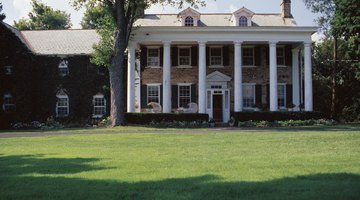What is the Difference Between Colonial & Federal Style Houses?
The Colonial and Federal style homes reflect the many changes in architecture that occurred as the American colonies grew into a nation. Dating from 1670 to 1820, the Colonial style shows a rougher, plainer type of dwelling.

Partially overlapping in dates, from 1790 to 1820, the Federal style portrays more relaxed, delicate and refined buildings.
Materials
Colonial builders used fieldstone, split shingles and handmade bricks in very simple fashions for their homes. Blacksmiths forged iron into hinges, handles and nails. Federal builders used brick for urban or high-scale homes and clapboard or matchboard for other dwellings. They added brass to iron hardware for a more delicate look, and used wood or iron fences for decoration instead of protection.
Exteriors
The characteristics of Colonial exteriors include very plain and unadorned walls, asymmetrical building features, and complex, mismatched additions and enlargements to the dwelling built over long periods of time. Federal exteriors show much more ornamentation, such as urns, garlands and festoons, on balanced and symmetrical buildings.
Roofs
Builders of Colonial houses focused on steeply pitched roofs with abrupt gables. Builders of Federal homes opted for hipped roofs.
Chimneys
Colonial builders placed chimneys in the center of the house or near the end walls. They built room additions in relationship to the chimneys, to keep them warm. Federal builders used smaller, narrower, and rectangular chimneys near the end walls. Because these homes had fewer additions, the shapes, sizes and locations of the interior rooms did not relate as closely to the chimney locations.
Windows
Placed asymmetrically, Colonial windows featured sashes with as many as nine or twelve small lights—or panes—and wide muntins—the wooden frames for the lights. The much more symmetrical Federal windows had larger openings with much larger and fewer lights and thinner muntins.
The Drip Cap
- The Colonial and Federal style homes reflect the many changes in architecture that occurred as the American colonies grew into a nation.
- Blacksmiths forged iron into hinges, handles and nails.
- Builders of Colonial houses focused on steeply pitched roofs with abrupt gables.
- Because these homes had fewer additions, the shapes, sizes and locations of the interior rooms did not relate as closely to the chimney locations.
References
- “A Field Guide to American Architecture;” Carole Rifkind; 1980
Writer Bio
Based in Brazos County, Texas, Jennifer Wiginton has been writing and editing since 1989. She has published two cookbooks and articles in “The Joyful Woman” and “The Common Bond.” Wiginton has two degrees and a Certificate in Homeland Security from Texas A&M University.
Photo Credits
- Comstock/Comstock/Getty Images
- Comstock/Comstock/Getty Images
More Articles



